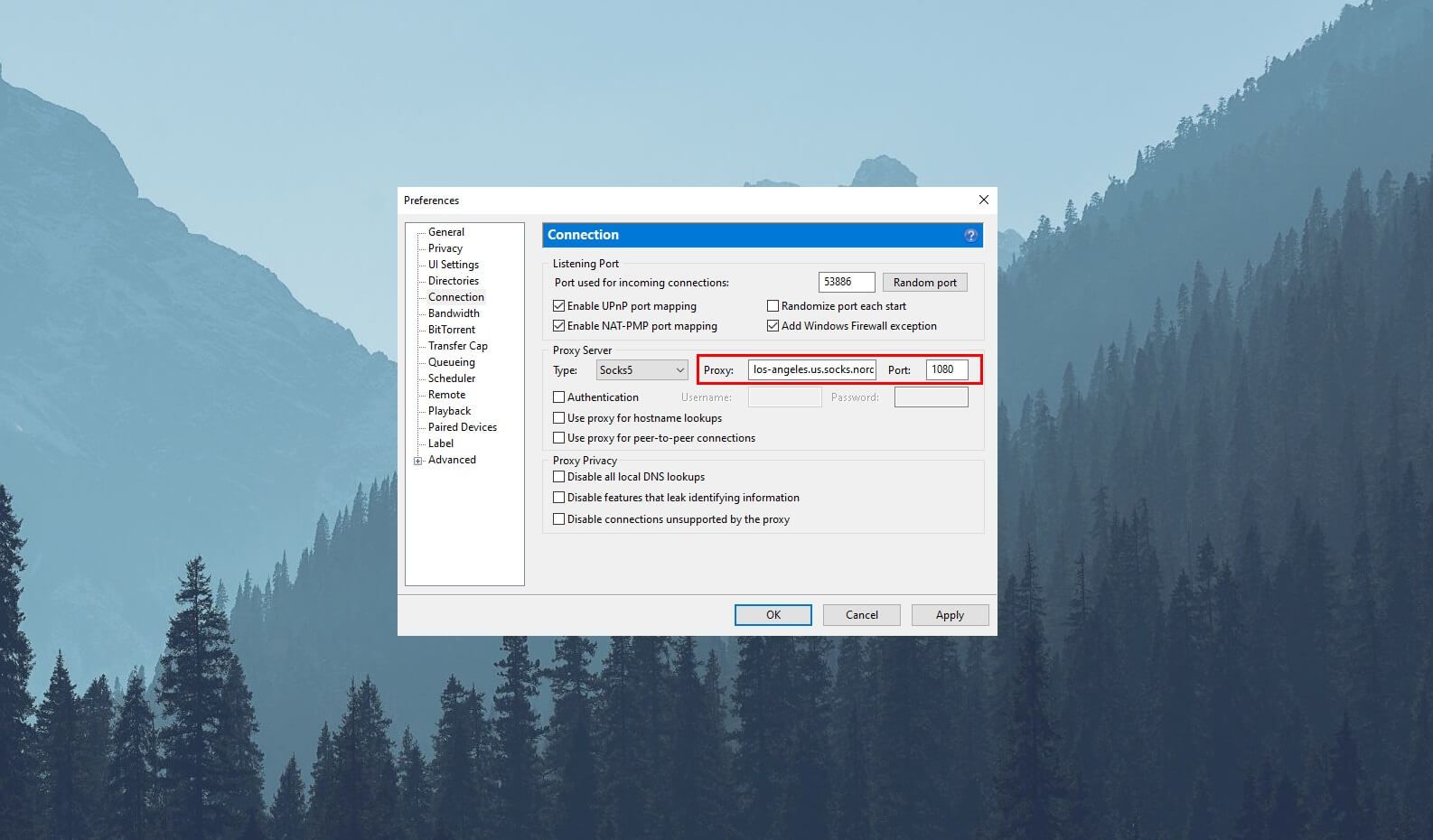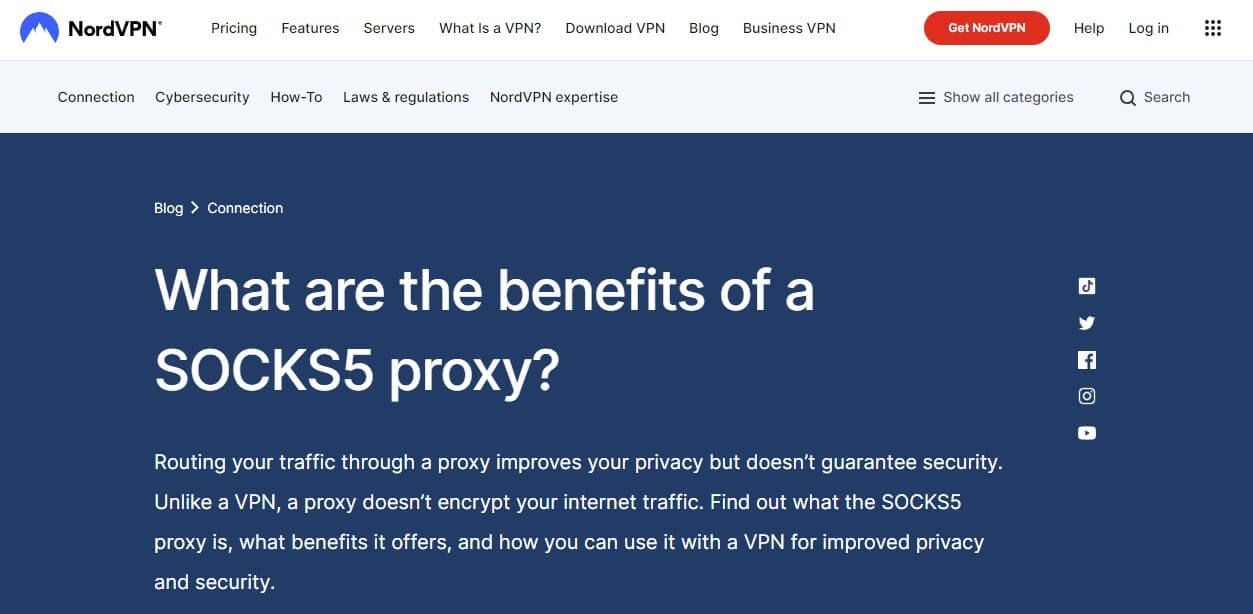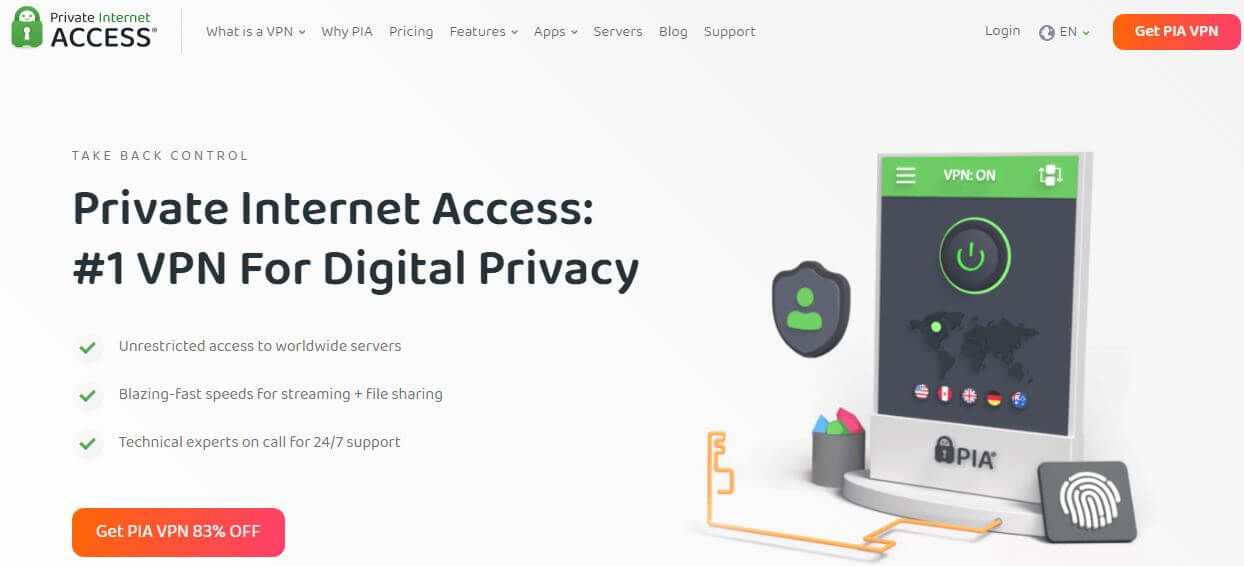When you hear the word proxy, you usually think about an intermediary server that routes your traffic. In fact, many people mix proxies and VPNs, mistaking them for one another. However, they’re not the same, as VPNs are vastly superior and offer encryption. There are many types of proxies, though. One of them is called the SOCKS5 proxy.
What is SOCKS5, you might be wondering? Well, it’s yet another type of proxy with a few additional security features that we’ll discuss in this article.
Most notably, this feature is offered by many VPN providers. This means that to use it, you’ll most likely need a subscription to one of the services that offer it. In today’s article, we’ll explain what is SOCKS5 proxy, compare it to VPNs, and see which providers will offer this feature.
What Is SOCKS5?
Let’s start this guide with the basics. First, we need to explain what is SOCKS5 because we don’t think many people are even aware of its existence. The word “SOCKS” here has nothing to do with your socks. Instead, it means Socket Secure.
Much like “normal” HTTP proxies or any other, it’ll route your traffic through an intermediary server and hide your original IP address. What’s more, this proxy works on the system level, which means it doesn’t have an effect only inside the browser.
Instead, it’s designed to work with every app or website. Furthermore, SOCKS5 takes advantage of the TCP/UDP connection, which is then established with another server behind the firewall. From here, network packets are exchanged between you and that server, while this firewall keeps things secure.
The good thing about SOCKS5 is that it doesn’t interpret the traffic that flows between you and the intermediary server. This immediately makes it more secure than “standard” proxies that you can find online. The number “5” in the name means this is the layer 5 protocol.
Of course, there is the SOCKS4 protocol as well, but SOCKS5 is more secure. Since it operates on layer 5, it “cares” only about information from that layer, while data from lower layers are irrelevant, some of which include your ARP or ping, for example.
To give you a rough idea of other layers, let’s mention layer 7, which is an SSL proxy. Then, layer 4 supports TCP/UDP connections, while layer 5 i.e. SOCKS5 proxy, supports not only UDP/TCP but also requests like HTTP, SMTP, FTP, HTTPS, and POP3. What does it mean?
In simple terms, it means SOCKS5 is more versatile and can be used even for torrenting, typical browsing, or sending emails.
SOCKS5 Authentication Methods
One of the major differences between SOCKS5 and SOCKS4 protocols lies in authentication. SOCKS4 doesn’t support it, making it less secure. On the flip side, SOCKS5 comes with 3 types of authentication, including:
- Null authentication. This means no authentication is required to connect to a proxy server.
- Username & password authentication. As its name explains, you need to enter your username and password each time you connect to a proxy server.
- GSS-API authentication. In this case, the user and the proxy server take advantage of authentication to verify the user’s identity and allow for the connection to be established.
SOCKS5 Proxy Main Advantages
Now that you know what is SOCKS5 and how it works, let’s discuss its advantages and use cases.
Unblocking Restricted Content
One of the main functions of the SOCKS5 proxy is getting over geo-blocks.
As said, this proxy will route your traffic through an intermediary server, which assigns you another IP address. By changing your IP address to another country, you can unblock geo-restricted content.
This is great if your IP is blacklisted and you can’t access the site you want, for instance. Just keep in mind that the SOCKS5 proxy usually won’t let you choose your new IP’s location, so it’s not reliable for changing regions on Netflix or other similar platforms.
But if you received a ban, let’s say, a solution like this will help you get over it in an instant. Also, when talking about unblocking sites, beware that SOCKS5 isn’t built for firewall restrictions. This especially applies to China and its Great Firewall that’ll easily detect SOCKS5 and block your connection.
For this scenario, it’s far better to use a VPN.
Torrenting & P2P
How does SOCKS5 work for torrenting? Judging by our experience, it’s actually pretty great in terms of performance. You can connect to SOCKS5 directly from the torrent client and enjoy excellent speeds and connection stability that SOCKS4 won’t offer.
That’s because it transfers smaller data packets, allowing for better download speed. We know many people use it when torrenting and it’s been known to improve speeds and stability drastically in plenty of cases. Just be careful because it’s not as secure as VPN!
Fast Speeds
SOCKS4’s main drawback is that it supports the TCP protocol. TCP is great for circumventing mild firewall restrictions and unblocking sites. It’s no wonder NordVPN uses OpenVPN TCP for its obfuscated servers to slider under the radar of the Great Firewall.
While SOCKS5 can’t do this, it does support TCP and UDP, unlike its predecessor that’s limited only to TCP connections. UDP is known for speed and stability, which is why the SOCKS5 proxy is faster. Not only that but this proxy can also cache data, improving the performance even further.
Support for Many Devices and Apps
Finally, the SOCKS5 proxy will work with pretty much any device or app. You can use the SOCKS5 configurator to get it working on torrent clients, gaming consoles, Smart TVs, or any other device/platform.
By the way, we have an article about the best VPNs for Smart TVs, so feel free to check it out. VPNs are, after all, much better at unblocking streaming services, making them far more suitable for TV users.
How to Use SOCKS5 Proxy
At the start, we mentioned that the SOCKS5 proxy comes as an additional feature in a VPN. Therefore, to use it, you’ll need to get a SOCKS5 VPN from our list below. From here, it’s a smooth sail, as it is used exactly the same as every other proxy.
Windows
If you’re wondering how to use SOCKS5 on iPhone, you should know that iOS can only take advantage of HTTP proxies. However, it is fully supported on Windows and macOS, so here’s a guide on how to use it, starting with Windows.
- Open Settings.
- Select Network & Internet.
- Click on Proxy.
- Under “Manual proxy setup”, click on “Set Up.”
- The button under “Use a proxy server” is OFF, so make sure to toggle it ON.
- From here, type in the proxy IP address and port that you’re provided by the selected VPN
- Click Save and close Settings.
macOS
While iOS doesn’t support SOCKS5, macOS does and it works really well on this platform. Let’s see how to use SOCKS5 on macOS – follow these steps:
- On your Mac, select System Preferences.
- Now click on Network, select Advanced, and find the option Proxies.
- Click on it and select “SOCKS proxy” from the list.
- Once again, enter the proxy IP and port number you received from the VPN provider.
- Click OK, close System Preferences, and you’re good to go.
Torrent Clients
We recently discussed uTorrent VPNs and explained that they can be used for safe and secure P2P activities. However, you can also use the SOCKS5 proxy specifically with torrent clients, such as uTorrent, BitTorrent, qBitTorrent, and many others.
This is pretty simple, especially if you use NordVPN SOCKS5, which is our recommended choice.
Follow the steps below:
- Open your torrent client. This setup guide applies to all notable clients we mentioned above.
- Open the Options menu. In qBitTorrent, you’ll find it under “Tools.” In uTorrent, you’ll find it above in the taskbar, and instead of Options, it’ll be called Preferences.
- From the Options menu, select Connection.
- Scroll down and find Proxy Server. Select SOCKS5 from the list.
- Under Proxy, enter the name of the server provided by NordVPN (or any other VPN). Check NordVPN’s SOCKS5 proxies here.
- For the Port number, enter 1080.
- Then, make sure you tick all the boxes underneath, as displayed in the image below (uTorrent).

© 01net.com (Screenshot taken from NordVPN’s site) - To enable authentication, simply enter your NordVPN service username and password that you can find on NordVPN’s site.
- Click Apply and then OK.
And if you don’t know how to get a NordVPN service username/password, here’s a guide:
- Go to NordVPN’s site and log in.
- Click on NordVPN under Services and select “Set up NordVPN manually.”
- Verify your email address through the security code sent by NordVPN.

© NordVPN - You’ll now see your service credentials, as displayed below. We blurred our credentials for privacy purposes but these are the ones you need to use in Step 8 above.
SOCKS5 vs VPN: Which Is Better?
If this SOCKS5 proxy is so good, what’s the point of using a VPN? First of all, it comes with many VPNs as an additional feature, so either way, you’ll need a VPN in the first place. Second, while SOCKS5 has obvious advantages over its predecessors, it’s still a PROXY. Remember that.
Proxies will conceal your IP address and spoof your location so that you access geo-restricted content easily. However, there’s a stark difference in how proxies and VPNs work. Proxies do NOT use an encrypted tunnel to secure your traffic, which is why they’re not secure.
This means your original IP address could still be detected by a hacker. With a VPN, you get 256-bit AES encryption that fully hides your IP and encrypts every bit of traffic, preventing even CIA-level hackers from intercepting your connector and reading its content.
In addition, the VPN also takes care of your DNS requests and routes them through its no-log DNS server. SOCKS5 won’t do that. While SOCKS5 is reasonably fast, a VPN is even faster thanks to advanced protocols like NordVPN’s NordLynx or WireGuard, which is supported by many other services.
When it comes to torrenting, a VPN is also more optimized. NordVPN, for example, has P2P servers that’ll take care of your security and allow for impressive performance. This is very important, as P2P activities are against your privacy by design, exposing your IP to other users in the network.
With a VPN, torrenting is completely anonymous and no one can trace your activities. Conversely, a VPN can also stop ISP throttling that often occurs. The downside is that VPNs are not free, but if you want to use SOCKS5 properly, you have to use a VPN and pay for it either way.
There are, however, free SOCKS5 proxy solutions but we don’t recommend using them for a variety of reasons. We’ll talk about them in a few minutes. As for our SOCKS5 vs VPN comparison, it’s clear that a VPN is much better, more secure, and significantly faster.
Best SOCKS5 Proxy VPN Providers for 2025
In 2025, you can’t find many quality SOCKS5 VPN services. But, as always, our team did extensive testing and research and found several providers we deem quality, secure, and reliable enough to give you a great experience.
1. NordVPN

The NordVPN SOCKS5 proxy is the best on this list. This provider packs TONS of features at an affordable price, along with 5,500 servers in 60 countries. It’s no coincidence that it’s one of the world’s favorite VPNs.
As we said previously, NordVPN is very simple to use and allows you to set up SOCKS5 in a minute.
Currently, it has these proxies in many countries, such as the US, Netherlands, Sweden, and a few others. Once you connect to one of them, you can enjoy fast torrenting and even streaming in some cases. However, we found NordVPN’s servers to be far more dependable for this purpose.
Still, this provider is known for exceptional security. It has 256-bit encryption, as well as features like the kill switch, IP/DNS leak protection, and even dedicated IP addresses. Another feature we like is the antivirus that comes in the Threat Protection package.
It’s available in every subscription plan and aside from that, you get malware protection and an ad blocker. Moreover, NordVPN has top-notch performance thanks to 10 Gbps servers, further enhanced with the NordLynx protocol that improves overall stability.
NordVPN can be used on any device and platform. Its SOCKS5 proxy is useful for uTorrent, Smart TVs, browsers, gaming consoles, and plenty of other systems. In addition, it’s worth mentioning that the provider supports 6 simultaneous connections per subscription.
And speaking of subscriptions, we recommend NordVPN’s 2-year plan with a heavy discount for added savings. Oh, and all plans offer a 30-day money-back guarantee, which means you can get a refund in the first 30 days if you don’t like it. We think it sounds more than fair!
Pros
- Many SOCKS5 locations
- Fast speeds
- 5,500+ servers
- Apps for all devices
- No logging
Cons
- VAT in some countries
2. Private Internet Access

Private Internet Access is yet another great VPN provider on this list. Needless to say, this PIA SOCKS5 solution offers exceptional speeds and performance, all while providing authentication and UDP/TCP connections. Unlike NordVPN, the provider has 30,000 servers in nearly 90 countries!
This allows for easy server switching and connecting to the nearest server for the best speeds. WireGuard is the protocol of choice for Private Internet Access, which ensures stable performance for streaming, torrenting, or browsing the web. In terms of the SOCKS5 proxy location, it’s not great, however.
You see, the proxy server of Private Internet Access is in the Netherlands and you can’t pick from other locations like in NordVPN. On the other hand, it’s simple to use, as you can find the credentials under your account on the site, the same way you did with NordVPN before.
Private Internet Access also supports Shadowsocks proxy, which is great for getting over certain firewall restrictions. Plus, users can enjoy PIA MACE, a great ad blocker, complemented by 256-bit encryption and a no-logs policy proven in court multiple times.
Private Internet Access is a great VPN if you’re looking for an advanced experience. It has MultiHop, obfuscation, and even the ability to change DNS parameters and choose different ports. Its apps aren’t the best and the Windows app tends to be a bit clunky at times.
Still, one thing that makes this VPN special is the price. Its longest plan is very affordable – even more than NordVPN – and along with other plans, has a 30-day refund policy. If you’re interested in getting its cheapest deal, make sure you click the button below.
Pros
- Excellent SOCKS5 support
- Ad blocker is included
- 30,000 servers worldwide
- MultiHop feature
Cons
- Clunky Windows client
- Average speeds
- Only 1 SOCKS5 location (NL)
3. IPVanish

The final pick on this list is IPVanish. This is another provider based in the US that offers SOCKS5, allowing for the same great benefits. We want to clarify that IPVanish isn’t a particularly impressive VPN overall, which can be seen in our ExpressVPN vs IPVanish comparison.
However, the provider boasts 2,200+ servers in 75+ locations, which is great for getting over geo-blocks. Another benefit is that its SOCKS5 proxy is easy to set up, and it even supports torrent clients. Of course, IPVanish is fully P2P-friendly, allowing for anonymous torrenting at any time.
In our numerous tests, the provider showed stellar, albeit not the best performance. Still, its WireGuard support provides excellent connection stability, as well as the ability to unblock Netflix. IPVanish is a no-log service and packs a good array of security features.
If you use the VPN, you’ll enjoy AES-256 encryption, a kill switch, and IP/DNS leak prevention. Despite being in the US, the service has a no-logs policy, so it won’t store your private data on any of its servers. In terms of device support, IPVanish is great.
You’ll get apps for iOS, Android, Windows, macOS, Linux, and even routers. On top of that, its price is relatively affordable and you can get a 2-year plan at just above $3 a month. Sure, it’s not more affordable than CyberGhost, but at least the SOCKS5 proxy option is here.
Important to clarify is that IPVanish has no refund policy for the monthly plan. But if you pick its yearly or 2-year plan, a 30-day refund policy will be in place. Not to mention unlimited simultaneous connections that no other VPN on this list will give you.
Pros
- WireGuard support
- AES-256 encryption
- SOCKS5 is easy to use
Cons
- It’s based in the US
- Average speeds
- No refund policy for the monthly plan
Free SOCKS5 Proxy: Is It A Good Thing?
Getting a free SOCKS5 proxy is an option as well, but there are plenty of issues with them. Free proxies are known for their privacy issues that go above the lack of encryption. Since something is free, it’s usually the user of that product that is the product.
In other words, when using free proxies, your private data, IP address, and browsing history are usually going to be monitored. As a result, if the authorities or any other third-party company requests this data, these proxies will comply and hand it out or sell the information to earn money.
Proxy servers also cost money to maintain. Low-cost solutions of free proxies usually aren’t very fast and frequently come with connection instabilities. On top of that, you’ll share the same server with thousands of users, which results in bandwidth congestion.
Another practice of free proxies is ad bombardment. You might’ve noticed it but many free proxies will display additional ads on top of the existing ones on the site you’re using. This is targeted advertisement, which, once again, tracks your browsing to precisely display ads according to your needs.
Compared to NordVPN SOCKS5 which comes as an addition to its premium subscription, free SOCKS5 proxy solutions are severely lacking. In NordVPN, the SOCKS5 proxy has no ads, it’s pretty fast, and NordVPN won’t use it to steal or sell your personal information.
Make sure you read our free vs paid VPN comparison as well. In this article, we explained that free VPNs do pretty much the same, which is why we don’t recommend any non-paid proxies/VPNs.
SOCKS5 vs HTTP Proxy: Is SOCKS5 Better?
SOCKS5 and HTTP proxies are identical when it comes to privacy – they don’t offer any due to the lack of encryption. Where they differ is flexibility. HTTP proxies, as their name implies, can handle HTTP and HTTPS requests and they’re limited to this possibility.
On the other hand, SOCKS5 proxies are far more flexible and can work with any requests and traffic. In addition to handling HTTP/HTTPS requests, they also support TCP/UDP connections and POP3, SMTP, and FTP requests.
HTTP/HTTPS is a high-level proxy compared to SOCKS5, which is a low-level proxy. The difference here is that HTTP proxies are designed and optimized for a specific protocol, granting slightly faster speeds, even though SOCKS5 is already fast.
However, you lack flexibility, as you can’t use it on every device, program, or protocol. SOCKS5, as you learned, can handle any request and can easily be used on every device or app without any particular limits. So, is an HTTP proxy worse than SOCKS5?
Well, yes and no. SOCKS5 is more secure and flexible, while HTTP can provide slightly faster speeds with the ability to set it up for content filtering and prevent users from accessing malicious sites. Either way, neither of the protocols is better than VPN, which is the epitome of safety and security.
Summary
To summarize, a SOCKS5 proxy is a great solution for ensuring decent performance, faster torrenting, and bypassing geo-blocks. These proxies come alongside quality VPNs like NordVPN, Private Internet Access, or IPVanish and are here to complement your VPN experience.
We do recommend using SOCKS5 for the particular cases we mentioned but with moderate expectations. It can’t get over heavy firewall restrictions and it has no encryption, making its lack of privacy evident compared to VPNs.
The good thing is that SOCKS5 is very easy to set up and requires no advanced technical knowledge. But even then, VPNs are far easier to use and come in the form of a simple app that even a complete dummy can get into. In the end, our choice boils down to a VPN.
And if you need a SOCKS5 VPN, there’s no better place to start than NordVPN. Check it out, claim its exclusive discount, and enjoy this proxy on all your devices.